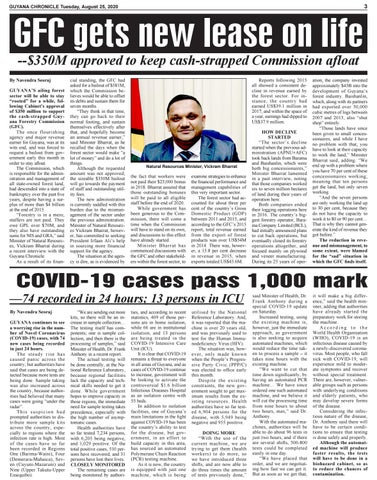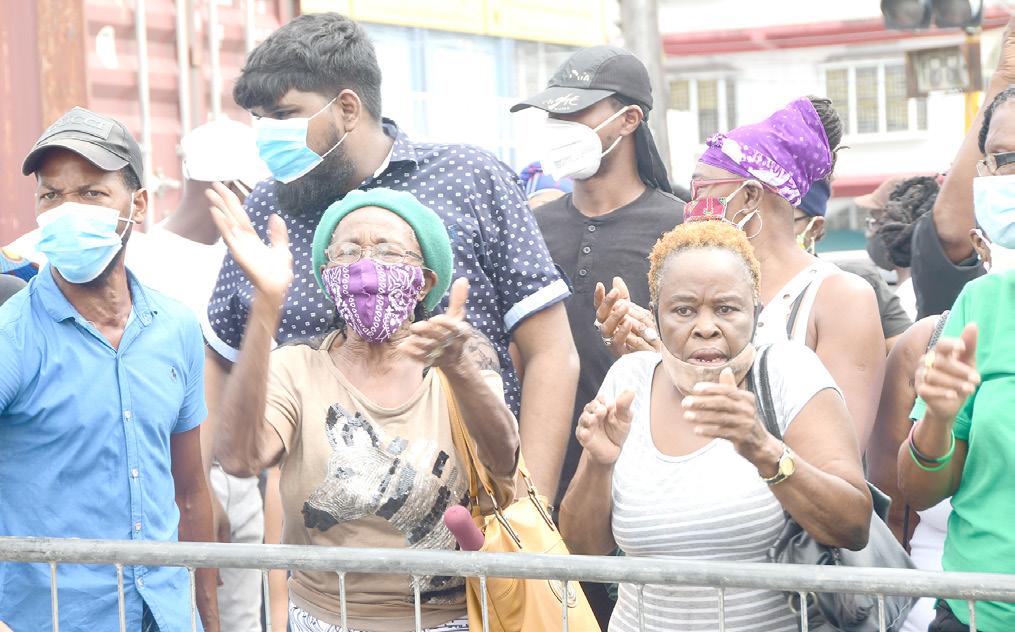3
GUYANA CHRONICLE Tuesday, August 25, 2020
GFC gets new lease on life --$350M approved to keep cash-strapped Commission afloat
By Navendra Seoraj GUYANA’S ailing forest sector will be able to stay “rooted” for a while, following Cabinet’s approval of $350 million to support the cash-strapped Guyana Forestry Commission (GFC). The once flourishing agency and major revenue earner for Guyana, was at its wits end, and was forced to request a bailout from government early this month in order to stay afloat. The Commission, which is responsible for the administration and management of all state-owned forest land, had descended into a state of bankruptcy over the past five years, despite having a surplus of more than $4 billion at the end of 2015. “Forestry is in a mess; staffers are not paid. They owe GPL over $70M, and they also have outstanding sums for NIS and GRA,” said Minister of Natural Resources, Vickram Bharrat during a recent interview with the Guyana Chronicle. As a result of its finan-
cial standing, the GFC had asked for a bailout of $581M, which the Commission believes would be able to offset its debts and sustain them for seven months. “They think in that time, they can go back to their normal footing, and sustain themselves effectively after that, and hopefully become an annual revenue earner,” said Minister Bharrat, as he recalled the days when the forest sector would make “a lot of money” and do a lot of things. Although the requested amount was not approved, the sizeable $350M bailout will go towards the payment of staff and outstanding utility fees. The new administration is currently saddled with this burden due to the mismanagement of the sector under the previous administration. Minister of Natural Resources Vickram Bharrat, however, has committed to seeking President Irfaan Ali’s help in sourcing more financial support for the agency. The situation at the agency is dire, as is evidenced by
Reports following 2015 all showed a consistent decline in revenue earned by the forest sector. For instance, the country had earned US$39.1 million in 2017, and within the space of a year, earnings had dipped to US$37.9 million.
Natural Resources Minister, Vickram Bharrat
the fact that workers were not paid their $25,000 bonus in 2018. Bharrat assured that those outstanding bonuses will be paid to all eligible staff before the end of 2020. While government has been generous to the Commission, there will come a time when the Commission will have to stand on its own, and discussions to this effect have already started. Minister Bharrat has commenced discussions with the GFC and other stakeholders within the forest sector, to
examine strategies to enhance the financial performance and management capabilities of this very important sector. The forest sector had accounted for about three per cent of the country’s Gross Domestic Product (GDP) between 2011 and 2015, and according to the GFC’s 2015 report, total revenue earned from the export of forest products was over US$54M in 2014. There was, however, a 15.8 per cent decrease in revenue in 2015, when exports totaled US$45.6M.
HOW DECLINE STARTED “The sector’s decline started when the previous administration (APNU+AFC) took back lands from Barama and Baishanlin, which were both big concessionaires,” Minister Bharrat lamented in a past interview, noting that those companies worked six to seven million hectares of land during their years of operation here. Both companies ended their logging operations here in 2016. The country’s biggest forestry operator, Barama Company Limited (BCL), had initially announced plans to cut back operations, but eventually closed its forestry operations altogether, and focused mainly on plywood and veneer manufacturing. During its 25 years of oper-
ation, the company invested approximately $45B into the development of Guyana’s forest industry. Baishanlin, which, along with its partners had exported over 50,000 cubic metres of logs between 2007 and 2015, also “shut shop” entirely. “Those lands have since been given to small concessionaires, and while I have no problem with that, you have to look at their capacity to work the land,” Minister Bharrat said, adding: “We end up with a problem where you have 70 per cent of these concessionaires working; meaning that ten persons get the land, but only seven working. “And the seven persons are only working the land up to 30 per cent, because they do not have the capacity to work it to 80 or 90 per cent… That is why they cannot generate the kind of revenue they got before.” The reduction in revenue and mismanagement, to some extent, were blamed for the “sad” situation in which the GFC finds itself.
COVID-19 cases pass 1,000 mark
––74 recorded in 24 hours; 13 persons in ICU By Navendra Seoraj GUYANA continues to see a worrying rise in the number of Novel Coronavirus (COVID-19) cases, with 74 new cases being recorded in just 24 hours. The steady rise has caused panic across the country, but authorities have said that cases are being detected because more tests are being done. Sample taking was also increased across the country, because authorities had believed that many cases were going “under the radar”. This suspicion had prompted authorities to distribute more sample kits across the country, especially to regions where the infection rate is high. Most of the cases have so far been recorded in Regions One (Barima-Waini), Four (Demerara-Mahaica), Seven (Cuyuni-Mazaruni) and Nine (Upper Takutu-Upper Essequibo).
“We are sending out more kits, so there will be an increase in sample collection… The testing itself has components; one is sample collection, and then there is the processing of samples,” said Minister of Health, Dr. Frank Anthony in a recent report. The actual testing will be done centrally, at the National Reference Laboratory, because regional facilities lack the capacity and technical skills needed to get it done. While government hopes to improve capacity in those regions, the immediate need for sample testing takes precedence, especially with the high number of asymptomatic cases. Health authorities have so far tested 7,234 persons, with 6,205 being negative, and 1,029 positive. Of the total positive cases, 510 persons have recovered, and 31 persons have lost their lives. CLOSELY MONITORED The remaining cases are being monitored by authori-
ties, and according to recent statistics, 409 of those persons are in home isolation, while 66 are in institutional isolation, and 13 persons are being treated in the COVID-19 Intensive Care Unit (ICU). It is clear that COVID-19 remains a threat to everyone in all areas of Guyana, and as cases of COVID-19 continue to increase, government will be looking to activate the controversial $1.6 billion Infectious Diseases Hospital as an isolation centre with 55 beds. In addition to isolation facilities, one of Guyana’s main limitations in the fight against COVID-19 has been the country’s ability to test for the disease, but government, in an effort to build capacity in this area, has sourced an automated Polymerase Chain Reaction (PCR) testing machine. As it is now, the country is equipped with just one machine, which is being
utilised by the National Reference Laboratory. And, it was reported that the machine is over 20 years old, and was previously used to test for the Human Immunodeficiency Virus (HIV). The situation was, however, only made known when the People’s Progressive Party Civic (PPP/C) was elected to office early this month. Despite the existing constraints, the new government sought to get maximum results from the existing resources. Health authorities have so far tested 6,904 persons for the disease, with 5,949 being negative and 955 positive. DOING MORE “With the use of the current machine, we are trying to get them (health workers) to do more, so we have introduced three shifts, and are now able to do three times the amount of tests previously done,”
said Minister of Health, Dr. Frank Anthony during a special COVID-19 update on Saturday. Increased testing, using the existing machine is, however, just the immediate approach, as government is also seeking to acquire automated machines, which would reduce the time taken to process a sample – it takes nine hours with the existing machine. “We want to cut that time down significantly, by having an automated PCR machine… We have since ordered one such automated machine, and we believe it will cut the processing time from nine hours to about two hours, max,” said Dr. Anthony. With the automated machines, authorities will be able to do about 96 tests in just two hours, and if there are several shifts, 500-800 tests could be completed easily in one day. “We have placed that order, and we are negotiating how fast we can get it. But as soon as we get that,
it will make a big difference,” said the health minister, adding that authorities have already started the preparatory work for storing the machine. According to the World Health Organisation (WHO), COVID-19 is an infectious disease caused by a newly-discovered coronavirus. Most people, who fall sick with COVID-19, will experience mild to moderate symptoms and recover without special treatment. There are, however, vulnerable groups such as persons with underlying conditions and elderly patients, who may develop severe forms of the disease. Considering the infectious nature of the disease, Dr. Anthony said there will have to be certain conditions to ensure that testing is done safely and properly. Although the automated machine will produce faster results, the tests will have to be done in a biohazard cabinet, so as to reduce the chances of contamination.



